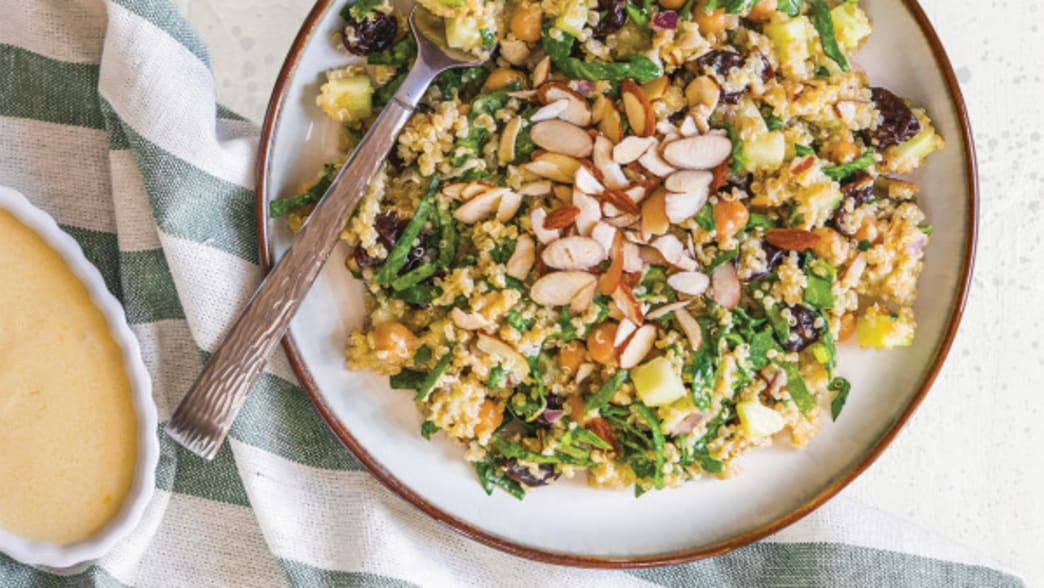Migraines and severe headaches are a debilitating – and common – ailment in the United States with 20% of women and almost 10% of men having had a severe headache or migraine in a three-month period, according to a Centers for Disease Control and Prevention (CDC) survey. If you’re one of them, put some relief on your plate with these 7 foods that ease headache pain.
Quinoa
This gluten-free seed is packed with nutrients proven to lower risk of migraines, including riboflavin, magnesium and iron. The high iron content of 1 cup cooked quinoa – 15% of the daily value (DV) – can protect against anemia, which has been associated with migraines. And it has sizable quantities of folate, a B vitamin shown to reduce migraine frequency in female migraine sufferers.
Try this: Toss cooked quinoa with chopped cucumbers, parsley, mint, green onions, feta cheese and a light vinaigrette for a gluten-free tabbouleh; cook quinoa, lentils, broccolini and red onions in a mixture of coconut milk and vegetable broth for a savory soup.
Cucumbers
Containing 96% water, they can help prevent dehydration, a known cause of many headaches. The reason? When the body is dehydrated, the brain temporarily shrinks and contracts, causing pain. In one study published in Family Practice, people with headaches reported a significant improvement in pain and overall quality of life when they increased their daily water intake by 1.5 liters. Other hydrating foods include celery, lettuce, peppers and tomatoes – all made up of at least 94% water.
Try this: Slice cucumbers crosswise then top with smoked salmon; blend peeled cucumber with lemonade and mint for a refreshing drink; purée with Greek yogurt, onions and garlic for a simple cold soup.
Cherries
Cherries consist of an array of polyphenol antioxidants, which have been shown to reduce inflammation, a major contributing factor in many headaches and migraines. Several studies have found reduced antioxidant activity and increased oxidative stress in patients with chronic migraine and medication-overuse headaches (a condition caused by overuse of pain-relief drugs).
Try this: Blend cherries with coconut milk, vanilla and honey and freeze in an ice-cream maker; dip whole cherries with stems in melted dark chocolate for an easy, elegant dessert.
Swiss Chard
The magnesium in Swiss chard and other leafy greens can help prevent a deficiency, which is more common in migraine sufferers than in healthy controls. In one study published in Nutrients, patients with chronic migraines reported significant improvement after taking 600 milligrams of magnesium daily for 12 weeks. And Swiss chard is also high in iron to prevent anemia. Spinach, beet greens and peanut butter also top the charts for magnesium levels.
Try this: Top a pizza with chopped chard leaves, sautéed mushrooms and leeks; sauté shredded chard, garlic and cherry tomatoes then toss with bucatini pasta and grated Asiago cheese.
Wild Alaskan Salmon
Salmon, sardines, tuna, mackerel and herring are full of omega-3 fatty acids, shown to decrease frequency of headaches. In a study conducted by Iranian researchers, lower intake of EPA and DHA – the type of omega-3 fatty acids found in salmon and other fatty fish – was associated with higher frequency of migraine attacks. In another study, 87% of adolescents who took omega-3 fish oil reported a reduction in headache frequency, 74% experienced a reduction in duration, and 83% had a reduction in severity.
Try this: Sauté smoked salmon, onions and shredded sweet potatoes into an easy breakfast hash; mix salmon with bread crumbs and seasonings and grill like a burger.
Shiitake Mushrooms
They’re a good source of riboflavin, a B vitamin that’s been shown to reduce the frequency and duration of migraine attacks with no serious side effects. In a study published in the International Journal for Vitamin and Nutrition Research, patients who took riboflavin reported a significant drop in headache frequency and were able to decrease their use of anti-migraine drugs.
Try this: Sauté sliced shiitakes in sesame oil then toss with a honey-miso glaze; finely chop shiitakes, ginger, garlic and green onions in a food processor and use as a stuffing for potstickers.
Black-Eyed Peas
Like other beans, peas and lentils, black-eyed peas offer a solid supply of high-fiber, plant-based protein. Studies show that a vegan diet may be associated with reduced migraine pain and reduced frequency of premenstrual headaches. Black-eyed peas and other legumes can help prevent chronic migraines, which have been linked with insulin resistance. And they’re a powerful source of headache-busting iron and magnesium.
Try this: Sauté black-eyed peas with shredded collards and sliced okra for a Southern-style side; toss black-eyed peas with chopped spinach, chopped red onion and diced red and yellow peppers; purée black-eyed peas with tahini, olive oil and garlic for a riff on hummus.
Written by Lisa Turner for Clean Eating Magazine and legally licensed through the Matcha publisher network. Please direct all licensing questions to legal@getmatcha.com.

